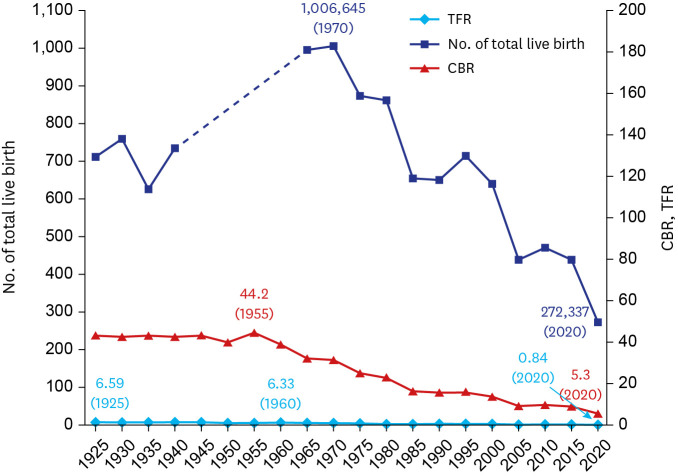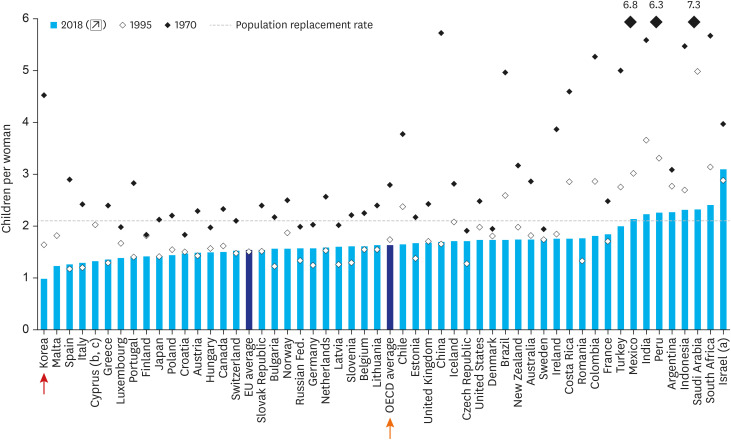J Korean Med Sci.
2022 Oct;37(42):e304. 10.3346/jkms.2022.37.e304.
Birth Rate Transition in the Republic of Korea: Trends and Prospects
- Affiliations
-
- 1Department of Pediatrics, CHA Ilsan Medical Center, CHA University School of Medicine, Goyang, Korea
- 2Department of Pediatrics, Kyung Hee University School of Medicine, Seoul, Korea
- KMID: 2534757
- DOI: http://doi.org/10.3346/jkms.2022.37.e304
Abstract
- Background
In Korea, the birth rate is declining at an alarming pace. This study aimed to investigate the changes and trends in the population count, number of births, and birth rate in Korea, in the past and future.
Methods
Data regarding the total number of births, crude birth rate, and total fertility rate were collected from the “Statistics Korea Census” of the national statistical portal, census report, and Statistics Korea’s “2020 Population Trend Survey for 1981–2020, provisional results of birth and death statistics.” We used the Organisation for Economic Co-operation and Development 2019 Family Database for the TFR. To develop a better understanding of the data in this study, we classified it according to the modern history of Korea.
Results
The changes and trends in the number of births and fertility rate in Korea, after liberation, were due to the birth control policy that restricted births. In Korea’s low fertility society, which began in the mid-2000s, the fertility rate dropped to below 0.84 in 2020, despite policies to improve the quality of the population. The death toll has reached 300,000, entering an era of population decline.
Conclusion
As we enter the era of population decline, we are in a direction that will cause various socioeconomic problems, from demographic problems to future population decline.
Keyword
Figure
Reference
-
1. Statistics Korea. Preliminary results of birth and death statistics in 2020. Updated 2021. Accessed November 20, 2021. http://kostat.go.kr/portal/korea/kor_nw/1/1/index.board?bmode=read&aSeq=388265 .2. Korean Statistical Information Service. Population, birth statistics. Updated 2021. Accessed November 20, 2021. https://kosis.kr/index/index.do .3. Organisation for Economic Co-operation and Development. Fertility rates. Updated 2020. Accessed November 20, 2021. https://data.oecd.org/pop/fertility-rates.htm .4. Presidential Committee on Aging Society and Population Policy (KR). The 1st plan for low birth rate and aging society in Korea (2006–2010). Updated 2018. Accessed July 25, 2021. https://www.betterfuture.go.kr/front/policySpace/basicPlanDetail.do;jsessionid=50834218BBCA6D108693F71F18E941BF.node20?articleId=1 .5. Presidential Committee on Aging Society and Population Policy (KR). The 2nd plan for low birth rate and aging society in Korea (2011–2015). Updated 2018. Accessed July 25, 2021. http://www.betterfuture.go.kr/front/policySpace/basicPlanDetail.do;jsessionid=7F428A894D1F2E3556A76E53B63388AE.node20?articleId=2 .6. Presidential Committee on Aging Society and Population Policy (KR). The 3rd plan for low birth rate and aging society in Korea (2016–2020). Updated 2020. Accessed July 25, 2021. https://www.korea.kr/archive/expDocView.do?docId=38961 .7. Ministry of Health and Welfare (KR). The 3rd plan for low birth rate and aging society in Korea (2016–2020) (revision). Updated 2016. Accessed July 25, 2021. http://www.mohw.go.kr/react/jb/sjb030301vw.jsp?PAR_MENU_ID=03&MENU_ID=0319&CONT_SEQ=329333&page=1&CONT_SEQ=329333&page=1 .8. Presidential Committee on Aging Society and Population Policy (KR). The 4th plan for low birth rate and aging society in Korea (2021–2025). Updated 2020. Accessed July 25, 2021. https://www.mohw.go.kr/react/gm/sgm0704vw.jsp?PAR_MENU_ID=13&MENU_ID=13040801&page=1&CONT_SEQ=358262&PAR_CONT_SEQ=356080 .9. Park GS. Population dynamics and structure during the Japanese colonial period. Korea J Popul Stud. 2009; 32(2):29–58.10. United Nations. World population prospects: population. Updated 2019. Accessed May 23, 2022. https://population.un.org/wpp/Download/Standard/Population/ .11. Roser M. Fertility rate (revision). Updated 2017. Accessed May 23, 2022. https://ourworldindata.org/fertility-rate?source=content_type%3Areact%7Cfirst_level_url%3Aarticle%7Csection%3Amain_content%7Cbutton%3Abody_link .12. United Nations. World population prospects: fertility. Updated 2019. Accessed May 23, 2022. https://population.un.org/wpp/Download/Standard/Fertility/ .13. Ki HA, Ho YK, Geum JC, Hong SC, Oh MJ, Kim HJ. Governmental policies for overcoming low birth rate by country. J Korean Soc Matern Child Health. 2018; 22(3):131–133.
Article14. Park JW, Yeo CK. A study on the economic impact and countermeasures to the demographic cliff due to the low birthrate and aging population: focusing on foreign case studies. J Corp Innov. 2021; 44(4):261–280.
- Full Text Links
- Actions
-
Cited
- CITED
-
- Close
- Share
- Similar articles
-
- Recent Trends in the Incidence of Multiple Births and Its Consequences on Perinatal Problems in Korea
- Trends and Changes of Maternal Age at Live Birth and Related Statistics in Korea (1981-2019)
- Changes in Survival Rate for Very-Low-Birth-Weight Infants in Korea: Comparison with Other Countries
- Recent Trends in Neonatal Mortality in Very Low Birth Weight Korean Infants: In Comparison with Japan and the USA
- Secular Trends of Gestational Length Distribution in Korean Singleton and Twin Birth: 1997~99, 2011~13



